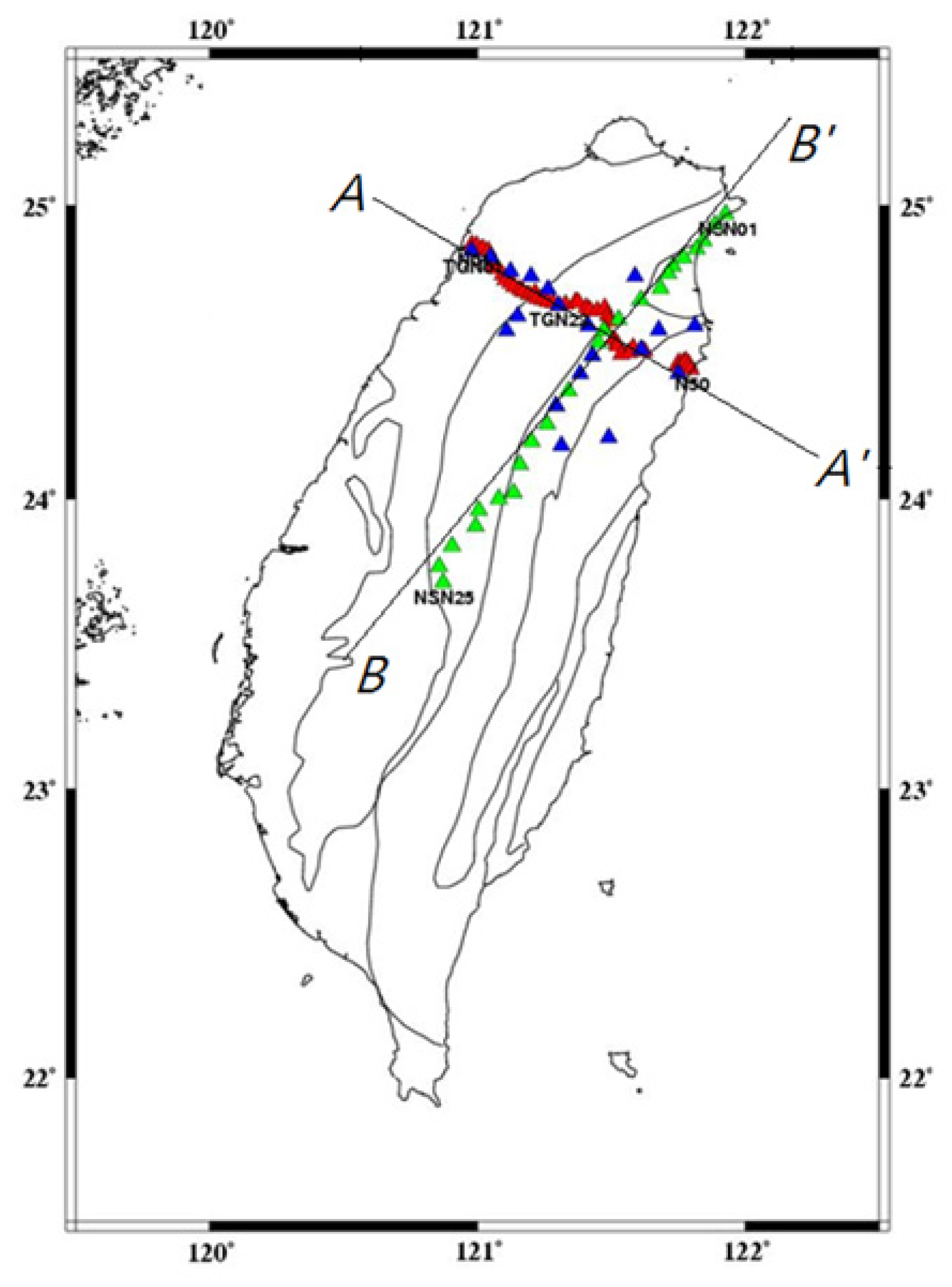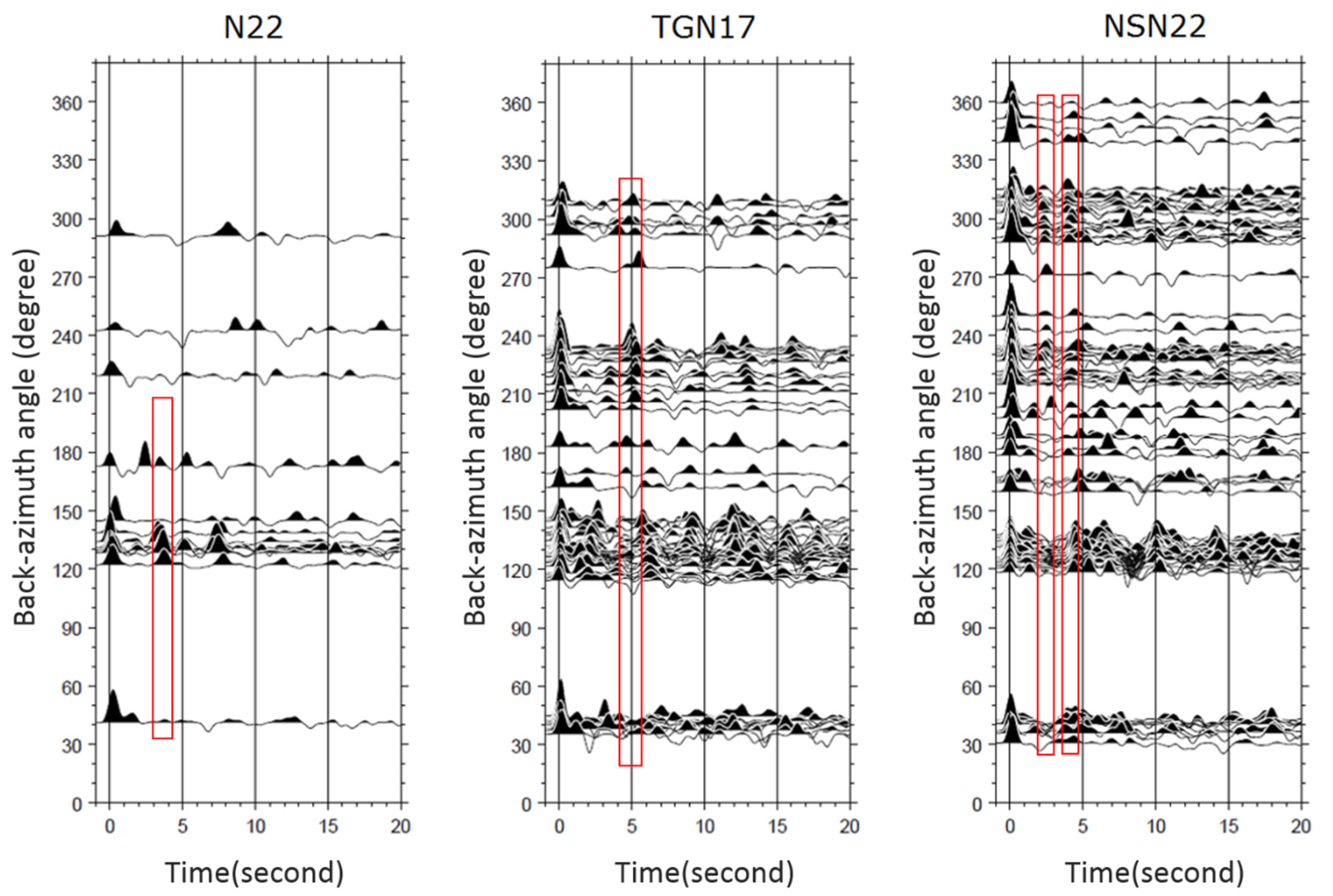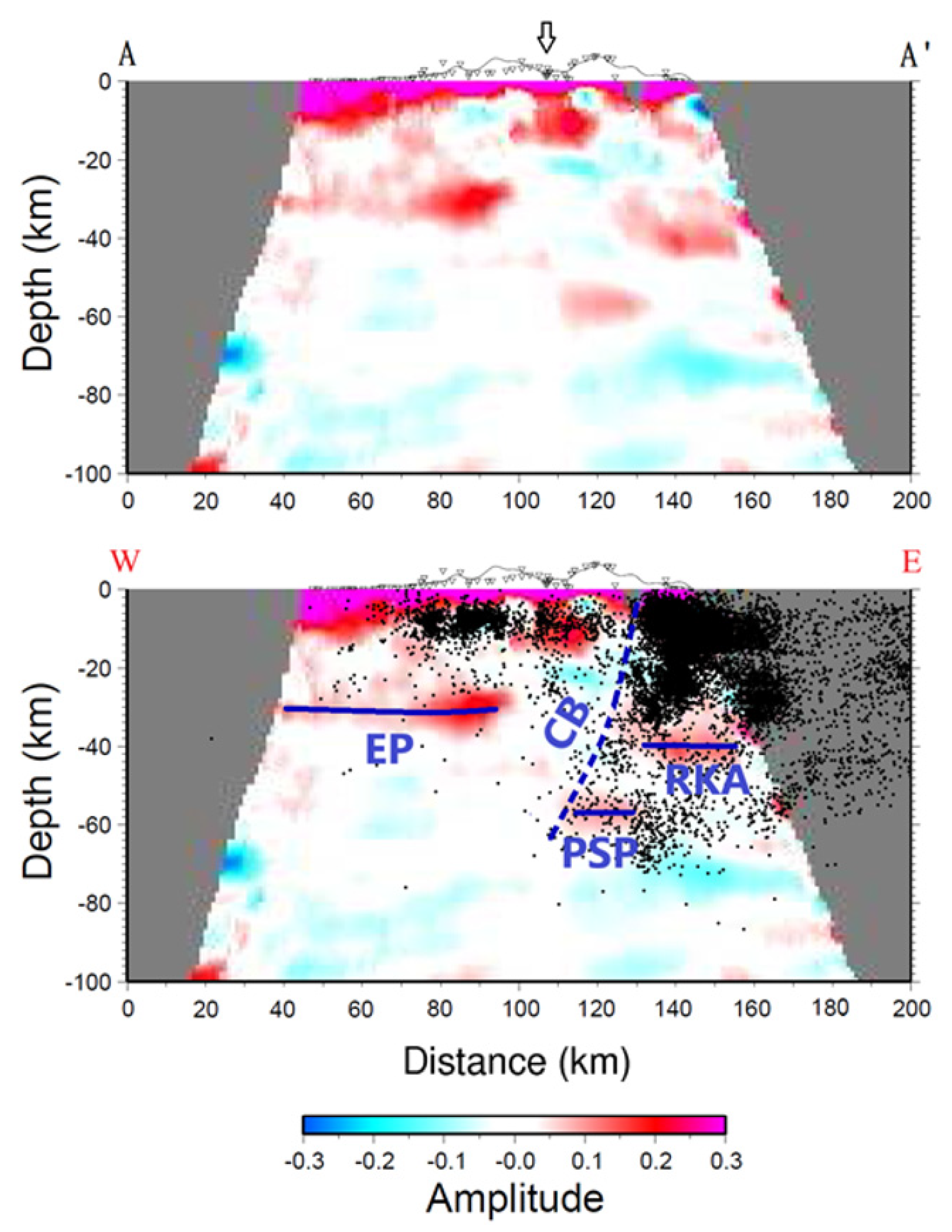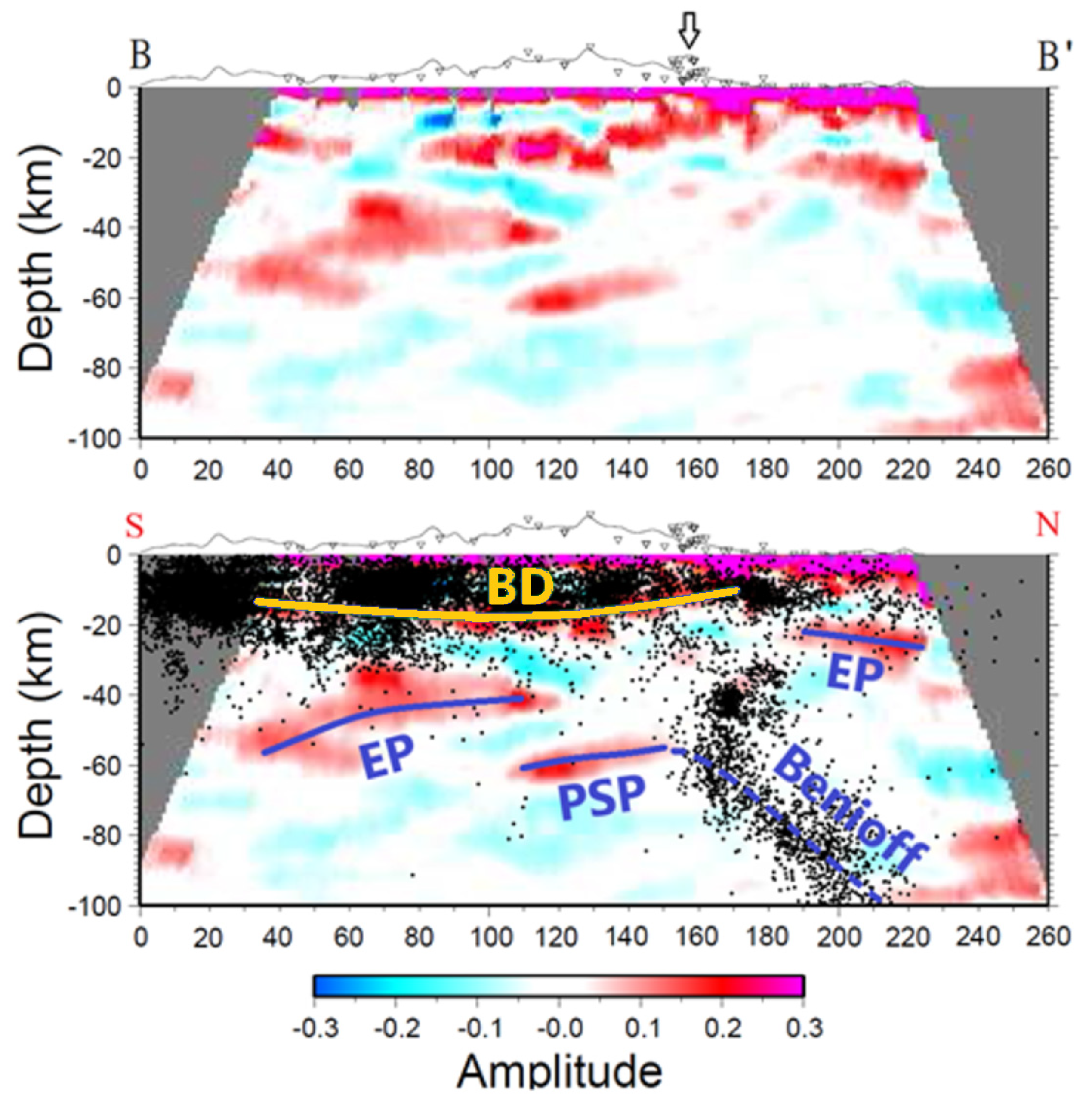Receiver Function Imaging of the Crustal Structure Beneath Northern Taiwan Using Dense Linear Arrays
Abstract
1. Introduction
2. Seismic Data
3. Methods of Receiver Function and CCP Stacking
3.1. Receiver Function
3.2. CCP Stacking (Common Conversion Point Stacking)
4. Imaging results
4.1. A-A′ Profile
4.2. B-B′ Profile
5. Discussions
6. Conclusions
Author Contributions
Funding
Data Availability Statement
Acknowledgments
Conflicts of Interest
References
- Ching, K.E.; Rau, R.J.; Johnson, K.M.; Lee, J.C.; Hu, J.C. Present-day kinematics of active mountain building in Taiwan from GPS observations during 1995–2005. J. Geophys. Res. 2011, 116, B09405. [Google Scholar] [CrossRef]
- Yu, S.B.; Chen, H.Y.; Kuo, L.C. Velocity field of GPS stations in the Taiwan area. Tectonophysics 1997, 274, 41–59. [Google Scholar] [CrossRef]
- Tsai, Y.B.; Teng, T.L.; Chiu, J.M.; Liu, H.L. Tectonic implications of the seismicity in the Taiwan region. Mem. Geol. Soc. China 1977, 2, 13–41. [Google Scholar]
- Suppe, J. Mechanics of mountain building and metamorphism in Taiwan. Mem. Geol. Soc. China 1981, 4, 67–89. [Google Scholar]
- Wu, F.T.; Rau, R.J.; Salzberg, D. Taiwan orogeny: Thin-skinned or lithospheric collision? Tectonophysics 1997, 274, 191–220. [Google Scholar] [CrossRef]
- Teng, L.S.; Lee, C.T.; Tsai, Y.B.; Hsiao, L.Y. Slab breakoff as a mechanism for flipping of subduction polarity in Taiwan. Geology 2000, 28, 155–158. [Google Scholar] [CrossRef]
- Lin, C.H. Active continental subduction and crustal exhumation: The Taiwan orogeny. Terra Nova 2002, 14, 281–287. [Google Scholar] [CrossRef]
- Wu, F.T.; Liang, W.T.; Lee, J.C.; Benz, H.; Villasenor, A. A model for the termination of the Ryukyu subduction zone against Taiwan: A junction of collision, subduction/separation, and subduction boundaries. J. Geophys. Res. 2009, 114, B07404. [Google Scholar] [CrossRef]
- Roecker, S.W.; Yeh, Y.H.; Tsai, Y.B. Three-dimensional P and S wave velocity structures beneath Taiwan; deep structure beneath an arc-continent collision. J. Geophys. Res. 1987, 92, 10547–10570. [Google Scholar] [CrossRef]
- Rau, R.J.; Wu, F.T. Tomographic imaging of lithospheric structures under Taiwan. Earth Planet. Sci. Lett. 1995, 133, 517–532. [Google Scholar] [CrossRef]
- Kim, K.H.; Chiu, J.M.; Pujol, J.; Chen, K.C.; Huang, B.S.; Yeh, Y.H.; Shen, P. Three-dimensional Vp and Vs structural model associated with the active subduction and collision tectonics in the Taiwan region. Geophys. J. Int. 2005, 162, 204–220. [Google Scholar] [CrossRef]
- Wu, Y.M.; Chang, C.H.; Zhao, L.; Shyu, J.B.H.; Chen, Y.G.; Sieh, K.; Avouac, J.P. Seismic tomography of Taiwan: Improved constraints from a dense network of strong motion stations. J. Geophys. Res. 2007, 112, B08312. [Google Scholar] [CrossRef]
- Kuo-Chen, H.; Wu, F.T.; Roecker, S.W. Three-dimensional P velocity structures of the lithosphere beneath Taiwan from the analysis of TAIGER and related seismic data sets. J. Geophys. Res. 2012, 117, B06306. [Google Scholar] [CrossRef]
- Phinney, R.A. Structure of the Earth’s crust from spectral behavior of long-period body waves. J. Geophys. Res. 1964, 62, 2997–3017. [Google Scholar] [CrossRef]
- Langston, C.A. Structure under Mount Rainier, Washington, inferred from teleseismic body waves. J. Geophys. Res. 1979, 84, 4749–4762. [Google Scholar] [CrossRef]
- Owens, T.J.; Zant, G.; Taylor, S.R. Seismic evidence for an ancient rift beneath the Crumberland Plateau, Tennessee: A Detailed analysis of broadband teleseismic P waveforms. J. Geophys. Res. 1984, 89, 7783–7795. [Google Scholar] [CrossRef]
- Ammon, C.J.; Randall, G.E.; Zandt, G. On the nonuniqueness of receiver function inversions. J. Geophys. Res. 1990, 95, 15303–15318. [Google Scholar] [CrossRef]
- Ammon, C.J. The isolation of receiver effects from teleseismic P waveforms. Bull. Seismol. Soc. Am. 1991, 81, 2504–2510. [Google Scholar] [CrossRef]
- Peng, X.; Humphreys, E.D. Crustal velocity structure across the eastern Snake River Plain and Yellowstone swell. J. Geophys. Res. 1998, 103, 7171–7186. [Google Scholar] [CrossRef]
- Xu, L.; Rondenay, S.; van der Hilst, R.D. Structure of the crust beneath the southeastern Tibetan Plateau from teleseismic receiver functions. Phys. Earth Planet. Inter. 2007, 165, 176–193. [Google Scholar] [CrossRef]
- Zhu, L. Crustal structure across the San Andreas Fault, southern California from teleseismic converted waves. Earth Planet. Sci. Lett. 2000, 179, 183–190. [Google Scholar] [CrossRef]
- Farra, V.; Vinnik, L. Upper mantle stratification by P and S receiver functions. Geophys. J. Int. 2000, 141, 699–712. [Google Scholar] [CrossRef]
- Chen, Y.; Niu, F.; Liu, R.; Huang, Z.; Tkalčić, H.; Sun, L.; Chan, W. Crustal structure beneath China from receiver function analysis. J. Geophys. Res. 2010, 115, B03307. [Google Scholar] [CrossRef]
- Tomfohrde, D.A.; Nowack, R.L. Crustal structure beneath Taiwan using frequency-band inversion of receiver function waveforms. Pure Appl. Geophys. 2000, 157, 737–764. [Google Scholar] [CrossRef][Green Version]
- Kim, K.H.; Chiu, J.M.; Kao, H.; Liu, Q.; Yeh, Y.H. A preliminary study of crustal structure in Taiwan area using receiver function analysis. Geophys. J. Int. 2004, 159, 146–164. [Google Scholar] [CrossRef]
- Wang, H.L.; Zhu, L.; Chen, H.W. Moho depth variation in Taiwan from teleseismic receiver functions. J. Asian Earth Sci. 2010, 37, 286–291. [Google Scholar] [CrossRef]
- Langston, C.A. The effect of planar dipping structure on source and receiver responses for constant ray parameter. Bull. Seismol. Soc. Am. 1977, 67, 1029–1050. [Google Scholar]
- Ligorría, J.P.; Ammon, C.J. Iterative deconvolution and receiver-function estimation. Seismol. Soc. Am. 1999, 89, 1395–1400. [Google Scholar] [CrossRef]
- Wu, Y.M.; Chang, C.H.; Zhao, L.; Teng, T.L.; Nakamura, M. A comprehensive relocation of earthquakes in Taiwan from 1991 to 2005. Bull. Seismol. Soc. Am. 2008, 98, 1471–1481. [Google Scholar] [CrossRef]
- Kidder, S.; Avouac, J.P.; Chan, Y.C. Constraints from rocks in the Taiwan orogen on crustal stress levels and rheology. J. Geophys. Res. 2012, 117, B09408. [Google Scholar] [CrossRef]
- Korhonen, H.; Porkka, M.T. The structure of the baltic shield region on the basis of DSS and earthquake data. Pure Appl. Geophys. 1981, 119, 1093–1099. [Google Scholar] [CrossRef]
- Kao, H.; Rau, R.J. Detailed structures of the subducted Philippine Sea plate beneath northeast Taiwan: A new type of double seismic zone. J. Geophys. Res. 1999, 104, 1015–1033. [Google Scholar] [CrossRef]
- Ustaszewski, K.; Wu, Y.M.; Suppe, J.; Huang, H.H.; Chang, C.H.; Carena, S. Crust-Mantle boundaries in the Taiwan-Luzon arc-continent collision system determined from local earthquake tomography and 1D models: Implications for the mode of subduction polarity reversal. Tectonophysics 2012, 578, 31–49. [Google Scholar] [CrossRef]
- Li, Z.; Roecker, S.; Kim, K.; Xu, Y.; Hao, T. Moho depth variations in the Taiwan orogen from joint inversion of seismic arrival time and Bouguer gravity data. Tectonophysics 2014, 632, 151–159. [Google Scholar] [CrossRef]
- Fu, L. Quantitative assessment of the complexity of geological structures in terms of seismic propagators. Sci. China. Earth Sci. 2010, 53, 54–63. [Google Scholar] [CrossRef]
- Zhu, L.; Kanamori, H. Moho depth variation in southern California from teleseismic receiver functions. J. Geophys. Res. 2000, 105, 2890–2969. [Google Scholar] [CrossRef]
- Goyal, A.; Hung, S.H. Lateral variations of Moho depth and average crustal properties across the Taiwan orogen from H-V stacking of P and S receiver functions. Geochem. Geophys. Geosyst. 2021, 22, e2020GC009527. [Google Scholar] [CrossRef]
- Rychert, C.A.; Harmon, N. Stacked P-to-S and S-to-P receiver functions determination of crustal thickness, Vp, and Vs: The H-V stacking method. Geophys. Res. Lett. 2016, 43, 1487–1494. [Google Scholar] [CrossRef]
- Hsieh, H.H.; Yen, H.Y. Three-dimensional density structures of Taiwan and tectonic implications based on the analysis of gravity data. J. Asian Earth Sci. 2016, 124, 247–259. [Google Scholar] [CrossRef]
- Carena, S.; Suppe, J.; Kao, H. Active detachment of Taiwan illuminated by small earthquakes and its control of first-order topography. Geology 2002, 30, 935–938. [Google Scholar] [CrossRef]
- Kind, R.; Eken, T.; Tilmann, F.; Sodoudi, F.; Taymaz, T.; Bulut, F.; Yuan, X.; Can, B.; Schneider, F. Thickness of the lithosphere beneath Turkey and surroundings from S-receiver functions. Solid Earth 2015, 6, 971–984. [Google Scholar] [CrossRef]
- Caldwell, W.B.; Klemperer, S.L.; Lawrence, J.F.; Rai, S.S.; Ashish. Characterizing the Main Himalayan thrust in the Garhwal Himalaya, India, with receiver function CCP stacking. Earth Planet. Sci. Lett. 2013, 367, 15–27. [Google Scholar] [CrossRef]






Publisher’s Note: MDPI stays neutral with regard to jurisdictional claims in published maps and institutional affiliations. |
© 2022 by the authors. Licensee MDPI, Basel, Switzerland. This article is an open access article distributed under the terms and conditions of the Creative Commons Attribution (CC BY) license (https://creativecommons.org/licenses/by/4.0/).
Share and Cite
Chi, T.-C.; Chang, Y.-F.; Huang, B.-S. Receiver Function Imaging of the Crustal Structure Beneath Northern Taiwan Using Dense Linear Arrays. Geosciences 2022, 12, 136. https://doi.org/10.3390/geosciences12030136
Chi T-C, Chang Y-F, Huang B-S. Receiver Function Imaging of the Crustal Structure Beneath Northern Taiwan Using Dense Linear Arrays. Geosciences. 2022; 12(3):136. https://doi.org/10.3390/geosciences12030136
Chicago/Turabian StyleChi, Tsung-Chih, Young-Fo Chang, and Bor-Shouh Huang. 2022. "Receiver Function Imaging of the Crustal Structure Beneath Northern Taiwan Using Dense Linear Arrays" Geosciences 12, no. 3: 136. https://doi.org/10.3390/geosciences12030136
APA StyleChi, T.-C., Chang, Y.-F., & Huang, B.-S. (2022). Receiver Function Imaging of the Crustal Structure Beneath Northern Taiwan Using Dense Linear Arrays. Geosciences, 12(3), 136. https://doi.org/10.3390/geosciences12030136






